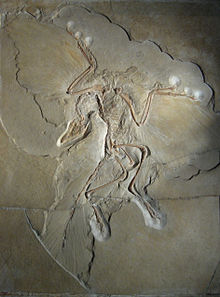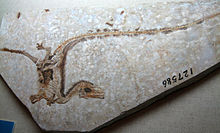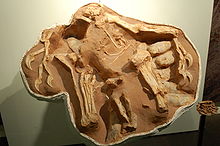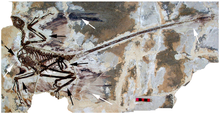- Feathered dinosaur
-
The realization that dinosaurs are closely related to birds raised the obvious possibility of feathered dinosaurs. Fossils of Archaeopteryx include well-preserved feathers, but it was not until the early 1990s that clearly non-avialan dinosaur fossils were discovered with preserved feathers. Since then, more than twenty genera of dinosaurs, mostly theropods, have been discovered to have been feathered. Most fossils are from the Yixian formation in China. The fossil feathers of one specimen, Shuvuuia deserti, have tested positive for beta-keratin, the main protein in bird feathers, in immunological tests.[1]
Contents
Early hypotheses
Main article: Origin of birdsShortly after the 1859 publication of Charles Darwin's On the Origin of Species, British biologist Thomas Henry Huxley proposed that birds were descendants of dinosaurs. He compared the skeletal structure of Compsognathus, a small theropod dinosaur, and the 'first bird' Archaeopteryx lithographica (both of which were found in the Upper Jurassic Bavarian limestone of Solnhofen). He showed that, apart from its hands and feathers, Archaeopteryx was quite similar to Compsognathus. In 1868 he published On the Animals which are most nearly intermediate between Birds and Reptiles, making the case.[2][3] The leading dinosaur expert of the time, Richard Owen, disagreed, claiming Archaeopteryx as the first bird outside dinosaur lineage. For the next century, claims that birds were dinosaur descendants faded, with more popular bird-ancestry hypotheses including 'crocodylomorph' and 'thecodont' ancestors, rather than dinosaurs or other archosaurs.
In 1964, John Ostrom described Deinonychus antirrhopus, a theropod whose skeletal resemblance to birds seemed unmistakable. Ostrom became a leading proponent of the theory that birds are direct descendants of dinosaurs. Further comparisons of bird and dinosaur skeletons, as well as cladistic analysis strengthened the case for the link, particularly for a branch of theropods called maniraptors. Skeletal similarities include the neck, the pubis, the wrists (semi-lunate carpal), the 'arms' and pectoral girdle, the shoulder blade, the clavicle and the breast bone. In all, over a hundred distinct anatomical features are shared by birds and theropod dinosaurs.
Other researchers drew on these shared features and other aspects of dinosaur biology and began to suggest that at least some theropod dinosaurs were feathered. The first restoration of a feathered dinosaur was Sarah Landry's depiction of a feathered "Syntarsus" (now renamed Megapnosaurus or considered a synonym of Coelophysis), in Robert T. Bakker's 1975 publication Dinosaur Renaissance.[4] Gregory S. Paul was probably the first paleoartist to depict maniraptoran dinosaurs with feathers and protofeathers, starting in the late 1970s.
By the 1990s, most paleontologists considered birds to be surviving dinosaurs and referred to 'non-avialan dinosaurs' (all extinct), to distinguish them from birds (Avialae). Before the discovery of feathered dinosaurs, the evidence was limited to Huxley and Ostrom's comparative anatomy. Some mainstream ornithologists, including Smithsonian Institution curator Storrs L. Olson, disputed the links, specifically citing the lack of fossil evidence for feathered dinosaurs.
Fossil evidence
After a century of hypotheses without conclusive evidence, well-preserved fossils of feathered dinosaurs were discovered during the 1990s, and more continue to be found. The fossils were preserved in a Lagerstätte — a sedimentary deposit exhibiting remarkable richness and completeness in its fossils — in Liaoning, China. The area had repeatedly been smothered in volcanic ash produced by eruptions in Inner Mongolia 124 million years ago, during the Early Cretaceous Period. The fine-grained ash preserved the living organisms that it buried in fine detail. The area was teeming with life, with millions of leaves, angiosperms (the oldest known), insects, fish, frogs, salamanders, mammals, turtles, lizards and crocodilians discovered to date.
The most important discoveries at Liaoning have been a host of feathered dinosaur fossils, with a steady stream of new finds filling in the picture of the dinosaur-bird connection and adding more to theories of the evolutionary development of feathers and flight. Norell et al. (2007) reported quill knobs from an ulna of Velociraptor mongoliensis, and these are strongly correlated with large and well-developed secondary feathers.[5]
Behavioural evidence, in the form of an oviraptorosaur on its nest, showed another link with birds. Its forearms were folded, like those of a bird.[6] Although no feathers were preserved, it is likely that these would have been present to insulate eggs and juveniles.[7]
Genuine feathers?
There have been claims that the supposed feathers of the Chinese fossils were a preservation artifact.[8] Despite doubts, the fossil feathers have roughly the same appearance as those of birds fossilized in the same locality, so there is no serious reason to think they are of different nature; moreover, no non-theropod fossil from the same site shows such an artifact, but sometimes show unambiguous hair (some mammals) or scales (some reptiles).[citation needed]
The "Archaeoraptor" fake
In 1999, a supposed 'missing link' fossil of an apparently feathered dinosaur named "Archaeoraptor liaoningensis", found in Liaoning Province, northeastern China, turned out to be a forgery. Comparing the photograph of the specimen with another find, Chinese paleontologist Xu Xing came to the conclusion that it was composed of two portions of different fossil animals. His claim made National Geographic review their research and they too came to the same conclusion.[9] The bottom portion of the "Archaeoraptor" composite came from a legitimate feathered dromaeosaurid now known as Microraptor, and the upper portion from a previously-known primitive bird called Yanornis.
Evidence in amber
In 2011, samples of amber were discovered to contain preserved feathers from 75 to 80 million years ago during the Cretaceous era, with evidence that they were from both dinosaurs and birds. Initial analysis suggests that some of the feathers were used for insulation, and not flight.[10] More complex feathers were revealed to have variations in coloration similar to modern birds, while simpler protofeathers were predominantly dark. Only 11 specimens are currently known. The specimens are too rare to be broken open to study their melanosomes, but there are plans for using non-destructive high-resolution X-ray imaging.[11]
Current knowledge
List of dinosaur genera preserved with evidence of feathers
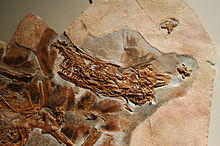 Fossil of Sinornithosaurus millenii, the first evidence of feathers in dromaeosaurids
Fossil of Sinornithosaurus millenii, the first evidence of feathers in dromaeosaurids
 Fossil cast of NGMC 91, an unnamed species
Fossil cast of NGMC 91, an unnamed species
A number of non-avialan dinosaurs are now known to have been feathered. Direct evidence of feathers exists for the following genera, listed in the order currently accepted evidence was first published. In all examples, the evidence described consists of feather impressions, except those genera inferred to have had feathers based on skeletal or chemical evidence, such as the presence of quill knobs (the anchor points for wing feathers on the forelimb) or a pygostyle (the fused vertebrae at the tail tip which often supports large feathers).
- Archaeopteryx (1861; possibly avialan)[12][13]
- Avimimus (inferred 1987: quill knobs)[14][15]
- Wellnhoferia (1988; possibly avialan)[13][16]
- Sinosauropteryx (1996)[17]
- Protarchaeopteryx (1997)[18]
- Caudipteryx (1998)[19]
- Rahonavis (inferred 1998: quill knobs; possibly avialan[20])[21]
- Shuvuuia (1999)[1]
- Sinornithosaurus (1999)[22]
- Beipiaosaurus (1999)[23]
- Microraptor (2000)[24]
- Nomingia (inferred 2000: pygostyle)[25]
- NGMC 91 (2001)[26]
- Psittacosaurus? (2002)[27]
- Yixianosaurus (2003)[28]
- Dilong (2004)[29]
- Pedopenna (2005; possibly avialan[30])[31]
- Jinfengopteryx (2005)[32][33]
- Juravenator (2006)[34][35]
- Sinocalliopteryx (2007)[36]
- Velociraptor (inferred 2007: quill knobs)[5]
- Similicaudipteryx (inferred 2008: pygostyle; confirmed 2010)[37][38]
- Anchiornis (2009)[39]
- Tianyulong? (2009)[40]
- Concavenator? (inferred 2010: quill knobs?)[41]
- Xiaotingia (2011)[13]
- The ornithmomimosaur Pelecanimimus was initially reported to preserve filamentous feathers. However, subsequent detailed study of the structure showed them to be muscle fibers.[42]
- Note, filamentous structures in some ornithischian dinosaurs (Psittacosaurus, Tianyulong) and pterosaurs may or may not be homologous with the feathers and protofeathers of theropods.[40][43]
Primitive feather types
Integumentary structures that gave rise to the feathers of birds are seen in the dorsal spines of reptiles and fish. A similar stage in their evolution to the complex coats of birds and mammals can be observed in living reptiles such as Iguanas and Gonocephalus Agamids. Feather structures are thought to have proceeded from simple hollow filaments through several stages of increasing complexity, ending with the large, deeply rooted, feathers with strong pens (rachis), barbs and barbules that birds display today.[44]
Some evidence suggests that the original function of simple feathers was insulation. In particular, preserved patches of skin in large, derived, tyrannosauroids show scutes, while those in smaller, more primitive, forms show feathers. This may indicate that the larger forms had complex skins, with both scutes and filaments, or that tyrannosauroids may be like rhinos and elephants, having filaments at birth and then losing them as they developed to maturity.[29] An adult Tyrannosaurus rex weighed about as much as an African Elephant. If large tyrannosauroids were endothermic, they would have needed to radiate heat efficiently, and feathers would have interfered with this.[45]
The fact that precursors of feathers appeared and then were co-opted for insulation is already present in Gould and Vrba, 1982.[46] The reason why such precursors appeared could be explained by a theory which is based on metabolic issue. Feathers are made of protein and contain substantial amounts of certain amino acids, especially cysteine. The protein complex at the base of the composition of the feather is keratin, which has disulfide bonds between amino acids that confer unique properties of stability and elasticity. The metabolism of amino acids containing sulfur proteins proved to be toxic to the organism. If the sulfur amino acids are not catabolized at the final products of urea or uric acid but used for the synthesis of keratin instead, the release of hydrogen sulfide is extremely reduced or avoided. For an organism whose metabolism works at high internal temperatures of 40 °C or greater can be extremely important to prevent the excess production of hydrogen sulfide. This hypothesis could be consistent with the need for high metabolic rate of theropod dinosaurs.[47][48]
It is not known with certainty at what point in archosaur phylogeny the earliest simple “protofeathers” arose, or if they arose once or, independently, multiple times. Filamentous structures are clearly present in pterosaurs, and long, hollow quills have been reported in specimens of the ornithischian dinosaurs Psittacosaurus and Tianyulong.[27][40] In 2009 Xu et al. noted that the hollow, unbranched, stiff integumentary structures found on a specimen of Beipiaosaurus were strikingly similar to the integumentary structures of psittacosaurus and pterosaurs. They suggested that all of these structures may have been inherited from a common ancestor much earlier in the evolution of archosaurs, possibly in an ornithodire from the Middle Triassic or earlier.[49]
Display feathers are also known from dinosaurs that are very primitive members of the bird lineage, or Avialae. The most primitive example is Epidexipteryx, which had a short tail with extremely long, ribbon - like, feathers. Oddly enough, the fossil does not preserve wing feathers, suggesting that Epidexipteryx was either secondarily flightless, or that display feathers evolved before flight feathers in the bird lineage.[50]
Phylogeny and the inference of feathers in other dinosaurs
Fossil feather impressions are extremely rare and they require exceptional preservation conditions to form. Therefore only a few feathered dinosaur genera have been identified so far. However, through a process called phylogenetic bracketing, scientists can infer the presence of feathers on poorly-preserved specimens. All fossil feather specimens have been found to show certain similarities. Due to these similarities and through developmental research almost all scientists agree that feathers could only have evolved once in dinosaurs. Feathers would then have been passed down to all later, more derived species (although it is possible that some lineages lost feathers secondarily). If a dinosaur falls at a point on an evolutionary tree within the known feather-bearing lineages, scientists assume it too had feathers, unless conflicting evidence is found. This technique can also be used to infer the type of feathers a species may have had, since the developmental history of feathers is now reasonably well-known.[44]
The scientists who described the (apparently unfeathered) Juravenator performed a genealogical study of coelurosaurs, including distribution of various feather types. Based on the placement of feathered species in relation to those that have not been found with any type of skin impressions, they were able to infer the presence of feathers in certain dinosaur groups. The following simplified cladogram follows these results, and shows the likely distribution of plumaceous (downy) and pennaceous (vaned) feathers among theropods.[51] Note that the authors inferred pennaceous feathers for Velociraptor based on phylogenetic bracketing, a prediction later confirmed by fossil evidence.[5]
Coelurosauria unnamed Albertosaurus (plumaceous feathers inferred)
Tyrannosaurus (plumaceous feathers inferred)
unnamed Compsognathidae Sinosauropteryx (plumaceous feathers)
unnamed Maniraptora unnamed Alvarezsauridae Patagonykus (plumaceous feathers inferred)
unnamed Shuvuuia (plumaceous feathers)
Mononykus (plumaceous feathers inferred)
unnamed Oviraptorosauria Caudipteryx (pennaceous feathers)
unnamed Conchoraptor (pennaceous feathers inferred)
Citipati (pennaceous feathers inferred)
unnamed unnamed Dromaeosauridae Microraptor (pennaceous feathers)
unnamed Velociraptor (pennaceous feathers inferred)
Sinornithosaurus (pennaceous feathers)
Archaeopteryx (pennaceous feathers)
Confuciusornis (pennaceous feathers)
See also
References
- ^ a b Schweitzer, M.H.; Watt, J.A.; Avci, R.; Knapp, L.; Chiappe, L.; Norell, M.; Marshall, M. (1999). "Beta-keratin specific immunological reactivity in feather-like structures of the Cretaceous Alvarezsaurid,Shuvuuia deserti". Journal of Experimental Zoology 285 (2): 146–57. doi:10.1002/(SICI)1097-010X(19990815)285:2<146::AID-JEZ7>3.0.CO;2-A. PMID 10440726.
- ^ Huxley, T.H. (1868). "On the animals which are most nearly intermediate between birds and reptiles". Annals and Magazine of Natural History.. 4th 2: 66–75. http://biodiversitylibrary.org/page/22247928.
- ^ Foster, Michael; Lankester, E. Ray 1898–1903. The scientific memoirs of Thomas Henry Huxley. 4 vols and supplement. London: Macmillan.
- ^ Paul, Gregory S. (2000). "A Quick History of Dinosaur Art". In Paul, Gregory S. (ed.). The Scientific American Book of Dinosaurs. New York: St. Martin's Press. pp. 107–112. ISBN 0-312-26226-4.
- ^ a b c Turner, A.H.; Makovicky, P.J.; and Norell, M.A. (2007). "Feather quill knobs in the dinosaur Velociraptor" (pdf). Science 317 (5845): 1721. Bibcode 2007Sci...317.1721T. doi:10.1126/science.1145076. PMID 17885130. http://www.sciencemag.org/cgi/reprint/317/5845/1721.pdf.
- ^ Norell M.A., Clark J.M., Chiappe L.M., Dashzeveg D. (1995). "A nesting dinosaur". Nature 378 (6559): 774–776. Bibcode 1995Natur.378..774N. doi:10.1038/378774a0.
- ^ Hopp, Thomas J., Orsen, Mark J. (2004) "Feathered Dragons: Studies on the Transition from Dinosaurs to Birds. Chapter 11. Dinosaur Brooding Behavior and the Origin of Flight Feathers" Currie, Koppelhaus, Shugar, Wright. Indiana University Press. Bloomington, IN. USA.
- ^ Feduccia, A; Lingham-Soliar, T; Hinchliffe, JR (2005). "Do feathered dinosaurs exist? Testing the hypothesis on neontological and paleontological evidence.". Journal of morphology 266 (2): 125–166. doi:10.1002/jmor.10382. PMID 16217748.
- ^ "Transcript: The Dinosaur that Fooled the World". BBC. http://www.bbc.co.uk/science/horizon/2001/dinofooltrans.shtml. Retrieved 2006-12-22.
- ^ Emily Chung (12 September 2011). "Dinosaur feathers found in Alberta amber". CBC. http://www.cbc.ca/news/canada/edmonton/story/2011/09/15/science-dinosaur-feathers.html. Retrieved 16 September 2011.
- ^ Brian Switek (15 September 2011). "Amber inclusions showcase prehistoric feathers". Nature News. doi:10.1038/news.2011.539. http://www.nature.com/news/2011/110915/full/news.2011.539.html?WT.ec_id=NEWS-20110920. Retrieved 22 September 2011.
- ^ von Meyer, H. (1861). Archaeopteryx litographica (Vogel-Feder) und Pterodactylus von Solenhofen. Neues Jahrbuch für Mineralogie, Geognosie, Geologie und Petrefakten-Kunde. 1861: 678–679, plate V [Article in German] Fulltext at Google Books.
- ^ a b c Xing Xu, Hailu You, Kai Du and Fenglu Han (28 July 2011). "An Archaeopteryx-like theropod from China and the origin of Avialae". Nature 475 (7357): 465–470. doi:10.1038/nature10288. PMID 21796204. http://www.nature.com/nature/journal/v475/n7357/full/nature10288.html.
- ^ Kurzanov, S.M. (1987). "Avimimidae and the problem of the origin of birds." Transactions of the Joint Soviet-Mongolian Paleontological Expedition, 31: 5-92. [in Russian]
- ^ Chiappe, L.M. and Witmer, L.M. (2002). Mesozoic Birds: Above the Heads of Dinosaurs. Berkeley: University of California Press, 536 pp. ISBN 0-520-20094-2
- ^ Wellnhofer, P. (1988). "A new specimen of Archaeopteryx". Science 240 (4860): 1790–1792. Bibcode 1988Sci...240.1790W. doi:10.1126/science.240.4860.1790.
- ^ Ji Q., Ji S. (1996). "On discovery of the earliest bird fossil in China and the origin of birds". Chinese Geology 10 (233): 30–33.
- ^ Ji, Q., and Ji, S. (1997). "A Chinese archaeopterygian, Protarchaeopteryx gen. nov." Geological Science and Technology (Di Zhi Ke Ji), 238: 38-41. Translated By Will Downs Bilby Research Center Northern Arizona University January, 2001
- ^ Currie, Philip J.; Qiang, Ji; Norell, Mark A.; Shu-An, Ji (1998). Nature 393 (6687): 753–761. Bibcode 1998Natur.393..753Q. doi:10.1038/31635.
- ^ Agnolin, F.L.; Novas, F.E. (2011). "Unenlagiid theropods: are they members of the Dromaeosauridae (Theropoda, Maniraptora)?" (PDF). Anais da Academia Brasileira de Ciências 83: 117–162. doi:10.1590/S0001-37652011000100008. http://www.scielo.br/pdf/aabc/v83n1/v83n1a08.pdf. Retrieved 2011-04-23.
- ^ Forster, Catherine A.; Sampson, Scott D.; Chiappe, Luis M. & Krause, David W. (1998a). "The Theropod Ancestry of Birds: New Evidence from the Late Cretaceous of Madagascar". Science 279 (5358): 1915–1919. Bibcode 1998Sci...279.1915F. doi:10.1126/science.279.5358.1915. PMID 9506938. (HTML abstract)
- ^ Wu, Xiao-Chun; Xu, Xing; Wang, Xiao-Lin (1999). Nature 401 (6750): 262–266. Bibcode 1999Natur.401..262X. doi:10.1038/45769.
- ^ Xu, Xing; Zhao, Xijin; Clark, James M. (2001). "A new therizinosaur from the Lower Jurassic lower Lufeng Formation of Yunnan, China". Journal of Vertebrate Paleontology 21 (3): 477–483. doi:10.1671/0272-4634(2001)021[0477:ANTFTL]2.0.CO;2. ISSN 0272-4634.
- ^ Xu, Xing; Zhou, Zhonghe; Wang, Xiaolin (2000). "The smallest known non-avian theropod dinosaur" (PDF). Nature 408 (6813): 705–708. doi:10.1038/35047056. PMID 11130069. http://research.amnh.org/%7Esunny/microraptor.pdf.
- ^ Barsbold R., Osmólska H., Watabe M., Currie P.J., Tsogtbaatar K. (2000). "New Oviraptorosaur (Dinosauria, Theropoda) From Mongolia: The First Dinosaur With A Pygostyle" (PDF). Acta Palaeontologica Polonica 45 (2): 97–106. http://www.app.pan.pl/archive/published/app45/app45-097.pdf.
- ^ Ji, Qiang; Norell, Mark A.; Gao, Ke-Qin; Ji, Shu-An; Ren, Dong (2001). "The distribution of integumentary structures in a feathered dinosaur". Nature 410 (6832): 1084–1087. Bibcode 2001Natur.410.1084J. doi:10.1038/35074079. PMID 11323669.
- ^ a b Mayr, Gerald; Peters, Stefan; Plodowski, Gerhard; Vogel, Olaf (2002). "Bristle-like integumentary structures at the tail of the horned dinosaur Psittacosaurus". Naturwissenschaften 89 (8): 361–365. Bibcode 2002NW.....89..361M. doi:10.1007/s00114-002-0339-6. PMID 12435037.
- ^ Xu X., Wang X.-L. (2003). "A new maniraptoran from the Early Cretaceous Yixian Formation of western Liaoning". Vertebrata PalAsiatica 41 (3): 195–202.
- ^ a b Xu, X., Norell, M. A., Kuang, X., Wang, X., Zhao, Q., Jia, C. (2004). "Basal tyrannosauroids from China and evidence for protofeathers in tyrannosauroids". Nature 431 (7009): 680–684. Bibcode 2004Natur.431..680X. doi:10.1038/nature02855. PMID 15470426. http://www.nature.com/nature/journal/v431/n7009/full/nature02855_fs.html.
- ^ Hone D.W.E., Tischlinger H., Xu X., Zhang F. (2010). Farke, Andrew Allen. ed. "The extent of the preserved feathers on the four-winged dinosaur Microraptor gui under ultraviolet light". PLoS ONE 5 (2): e9223. Bibcode 2010PLoSO...5.9223H. doi:10.1371/journal.pone.0009223. http://www.plosone.org/article/info%3Adoi%2F10.1371%2Fjournal.pone.0009223.
- ^ Xu, Xing; Zhang, Fucheng (2005). "A new maniraptoran dinosaur from China with long feathers on the metatarsus". Naturwissenschaften 92 (4): 173–177. Bibcode 2005NW.....92..173X. doi:10.1007/s00114-004-0604-y. PMID 15685441.
- ^ Ji Q., Ji S., Lu J., You H., Chen W., Liu Y., Liu Y. (2005). "First avialan bird from China (Jinfengopteryx elegans gen. et sp. nov.)". Geological Bulletin of China 24 (3): 197–205.
- ^ Turner, Alan H.; Pol, Diego; Clarke, Julia A.; Erickson, Gregory M.; and Norell, Mark (2007). "A basal dromaeosaurid and size evolution preceding avian flight" (pdf). Science 317 (5843): 1378–1381. Bibcode 2007Sci...317.1378T. doi:10.1126/science.1144066. PMID 17823350. http://www.sciencemag.org/cgi/reprint/317/5843/1378.pdf.
- ^ Goehlich U.B., Tischlinger H., Chiappe L.M. (2006). "Juraventaor starki (Reptilia, Theropoda) ein nuer Raubdinosaurier aus dem Oberjura der Suedlichen Frankenalb (Sueddeutschland): Skelettanatomie und Wiechteilbefunde". Archaeopteryx 24: 1–26.
- ^ Chiappe, Luis M.; Göhlich, Ursula B. (2010). "Anatomy of Juravenator starki (Theropoda: Coelurosauria) from the Late Jurassic of Germany". Neues Jahrbuch für Geologie und Paläontologie - Abhandlungen 258 (3): 257–296. doi:10.1127/0077-7749/2010/0125.
- ^ Ji S., Ji Q., Lu J., Yuan C. (2007). "A new giant compsognathid dinosaur with long filamentous integuments from Lower Cretaceous of Northeastern China". Acta Geologica Sinica 81 (1): 8–15.
- ^ He T., Wang X.-L., Zhou Z.-H. (2008). "A new genus and species of caudipterid dinosaur from the Lower Cretaceous Jiufotang Formation of western Liaoning, China". Vertebrata PalAsiatica 46 (3): 178–189.
- ^ Xu, Xing; Zheng, Xiaoting; You, Hailu (2010). "Exceptional dinosaur fossils show ontogenetic development of early feathers". Nature 464 (7293): 1338–1341. Bibcode 2010Natur.464.1338X. doi:10.1038/nature08965. PMID 20428169.
- ^ Xu, X., Zhao, Q., Norell, M., Sullivan, C., Hone, D., Erickson, G., Wang, X., Han, F. and Guo, Y. (in press). "A new feathered maniraptoran dinosaur fossil that fills a morphological gap in avian origin." Chinese Science Bulletin, 6 pages, accepted November 15, 2008.
- ^ a b c Zheng, Xiao-Ting; You, Hai-Lu; Xu, Xing; Dong, Zhi-Ming (2009). "An Early Cretaceous heterodontosaurid dinosaur with filamentous integumentary structures". Nature 458 (7236): 333–336. Bibcode 2009Natur.458..333Z. doi:10.1038/nature07856. PMID 19295609.
- ^ Ortega, Francisco; Escaso, Fernando; Sanz, José L. (2010). "A bizarre, humped Carcharodontosauria (Theropoda) from the Lower Cretaceous of Spain". Nature 467 (7312): 203–206. Bibcode 2010Natur.467..203O. doi:10.1038/nature09181. PMID 20829793.
- ^ Briggs, D. E. G.; Wilby, P. R.; Perez-Moreno, B. P.; Sanz, J. L.; Fregenal-Martinez, M. (1997). "The mineralization of dinosaur soft tissue in the Lower Cretaceous of Las Hoyas, Spain". Journal of the Geological Society 154 (4): 587–588. doi:10.1144/gsjgs.154.4.0587.
- ^ Czerkas, S.A., and Ji, Q. (2002). "A new rhamphorhynchoid with a headcrest and complex integumentary structures." Pp. 15-41 in: Czerkas, S.J. (Ed.). Feathered Dinosaurs and the Origin of Flight. Blanding, Utah: The Dinosaur Museum. ISBN 1-932075-01-1.
- ^ a b Prum, R. & Brush A.H. (2002). "The evolutionary origin and diversification of feathers". The Quarterly Review of Biology 77 (3): 261–295. doi:10.1086/341993. PMID 12365352.
- ^ Norell, M. Xu, X. (2005) "The Varieties of Tyrannosaurs" Natural History Magazine May, 2005. http://www.naturalhistorymag.com/htmlsite/master.html?http://www.naturalhistorymag.com/htmlsite/0505/0505_feature.html
- ^ Gould, Stephen J. and Vrba, Elisabeth S. (1982). "Exaptation: a missing term in the science of form". Paleobiology 8 (1): 4–15.
- ^ Reichholf, J. H. (1996). "Die Feder, die Mauser und der Urspring der Vögel. Ein neure Sicht zur Evolution der Vögel". Archaeopteryx 1427 (38).
- ^ Bock, W. J. (2000). "Explanatory History of the Origin of Feathers". Amer. Zool. 40 (4): 478–485. doi:10.1093/icb/40.4.478.
- ^ Xu, X.; Zheng, X.; You, H. (2009). "From the Cover: A new feather type in a nonavian theropod and the early evolution of feathers". Proceedings of the National Academy of Sciences 106 (3): 832–4. Bibcode 2009PNAS..106..832X. doi:10.1073/pnas.0810055106. PMC 2630069. PMID 19139401. http://www.pubmedcentral.nih.gov/articlerender.fcgi?tool=pmcentrez&artid=2630069.
- ^ Zhang, Fucheng; Zhou, Zhonghe; Xu, Xing; Wang, Xiaolin; Sullivan, Corwin (2008). "A bizarre Jurassic maniraptoran from China with elongate ribbon-like feathers". Nature 455 (7216): 1105–8. Bibcode 2008Natur.455.1105Z. doi:10.1038/nature07447. PMID 18948955. http://www.nature.com/nature/journal/v455/n7216/full/nature07447.html.
- ^ Göhlich, Ursula B.; Chiappe, Luis M. (2006). "A new carnivorous dinosaur from the Late Jurassic Solnhofen archipelago". Nature 440 (7082): 329–332. Bibcode 2006Natur.440..329G. doi:10.1038/nature04579. PMID 16541071.
External links
- DinoBuzz, dinosaur-bird controversy explained, by UC Berkeley.
- Journal of Dinosaur Paleontology, with many articles on dinosaur-bird links.
- Life-like images of feathered dinosaurs
Categories:- Coelurosaurs
- Feathered dinosaurs
- Biological evolution
Wikimedia Foundation. 2010.


